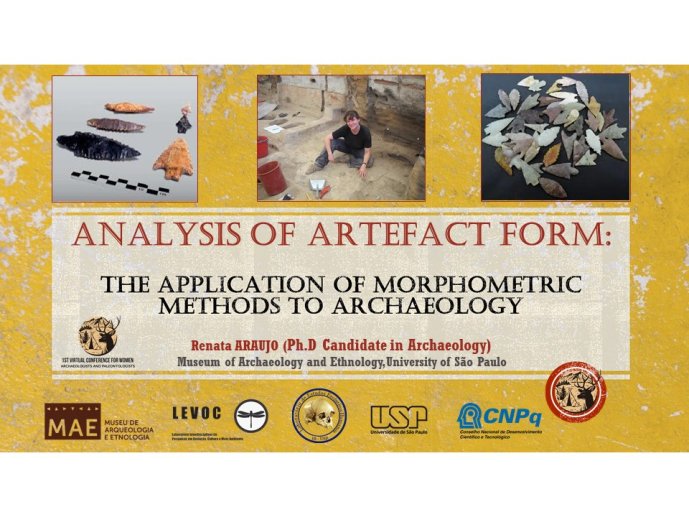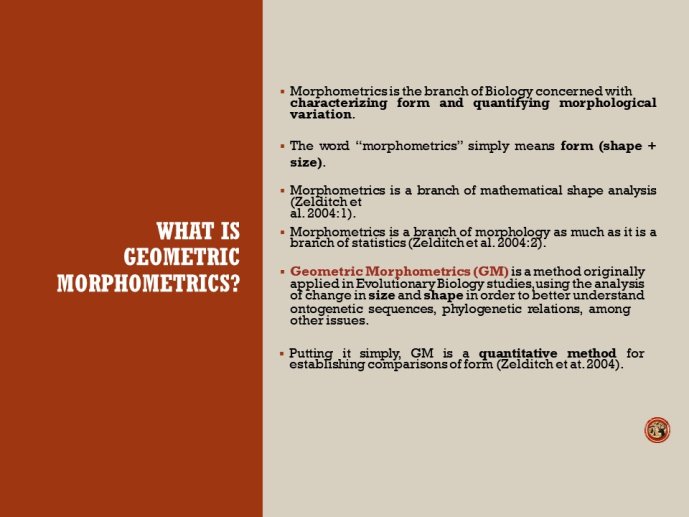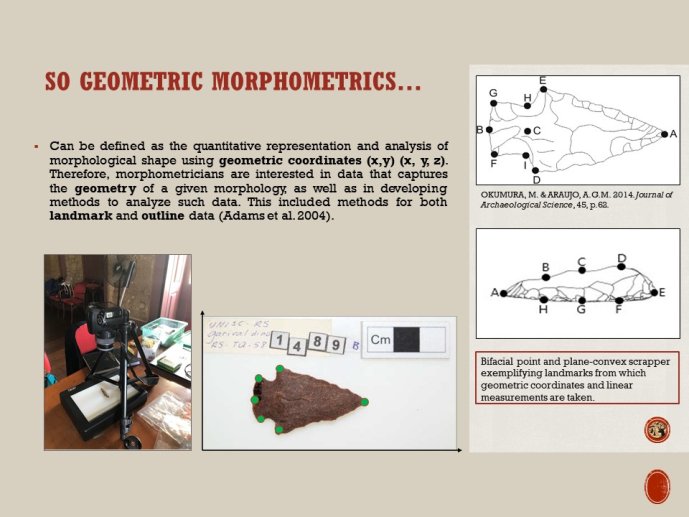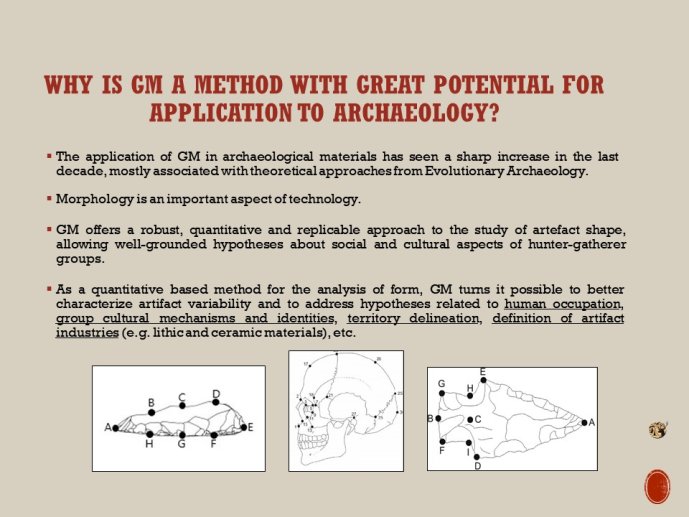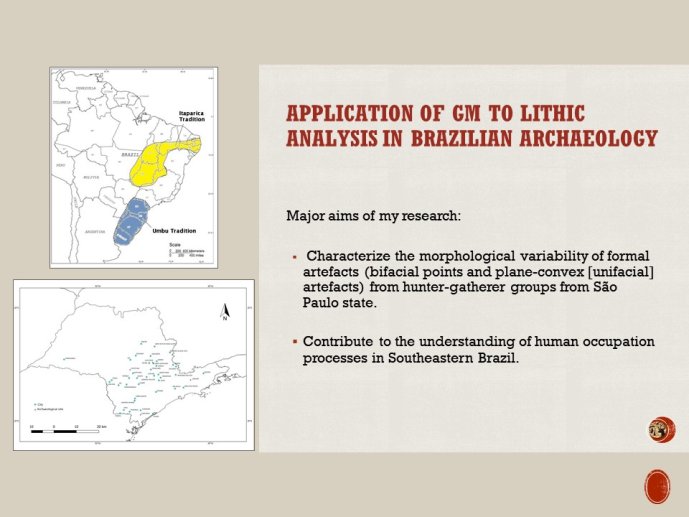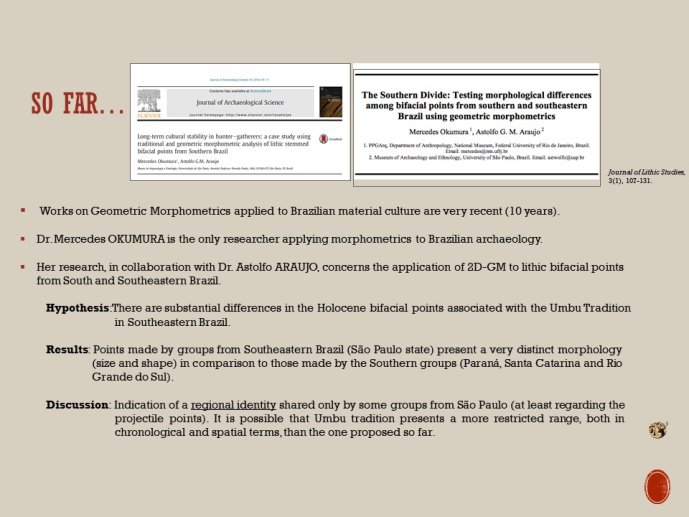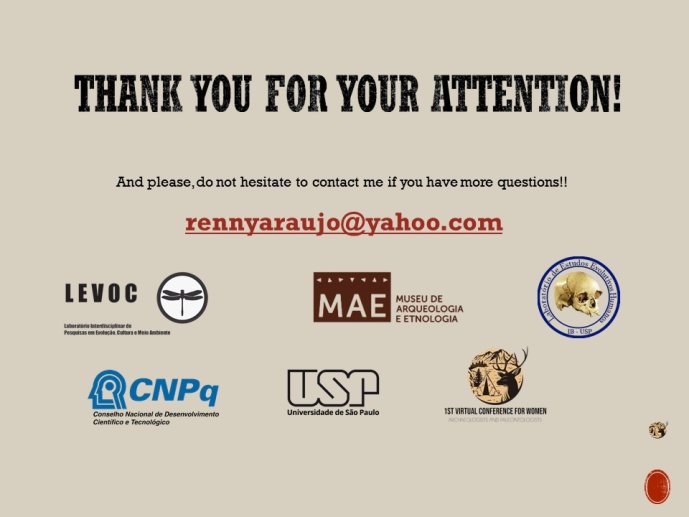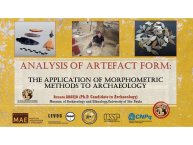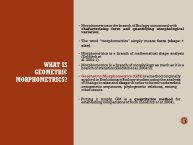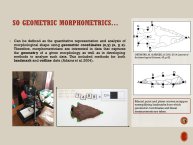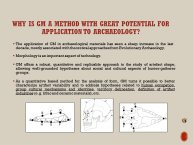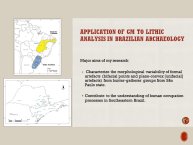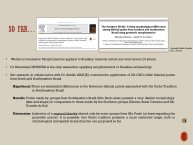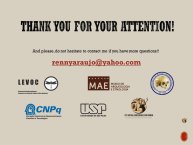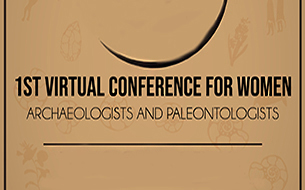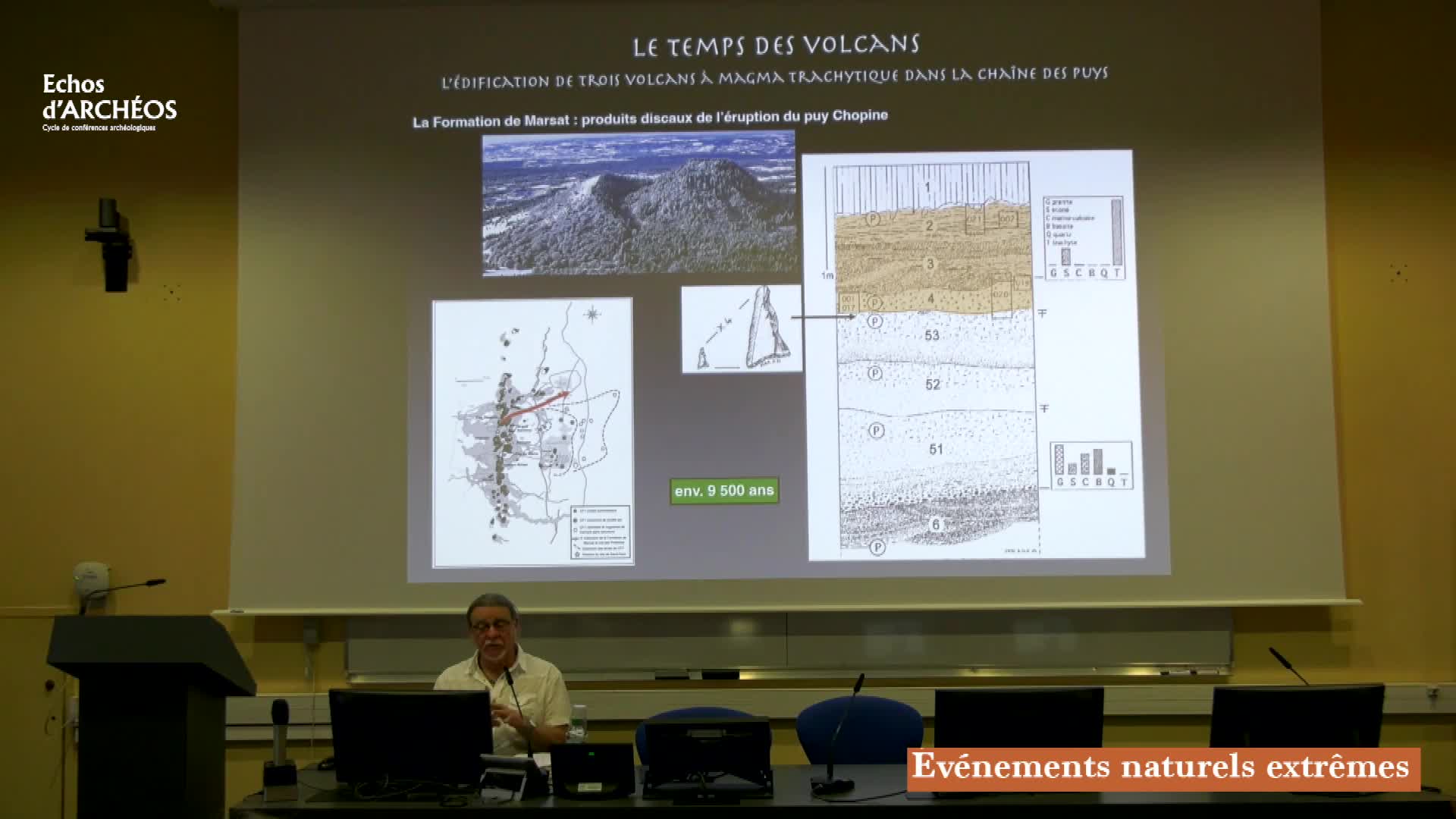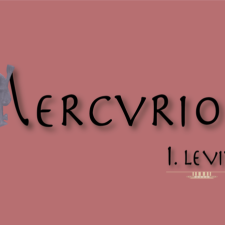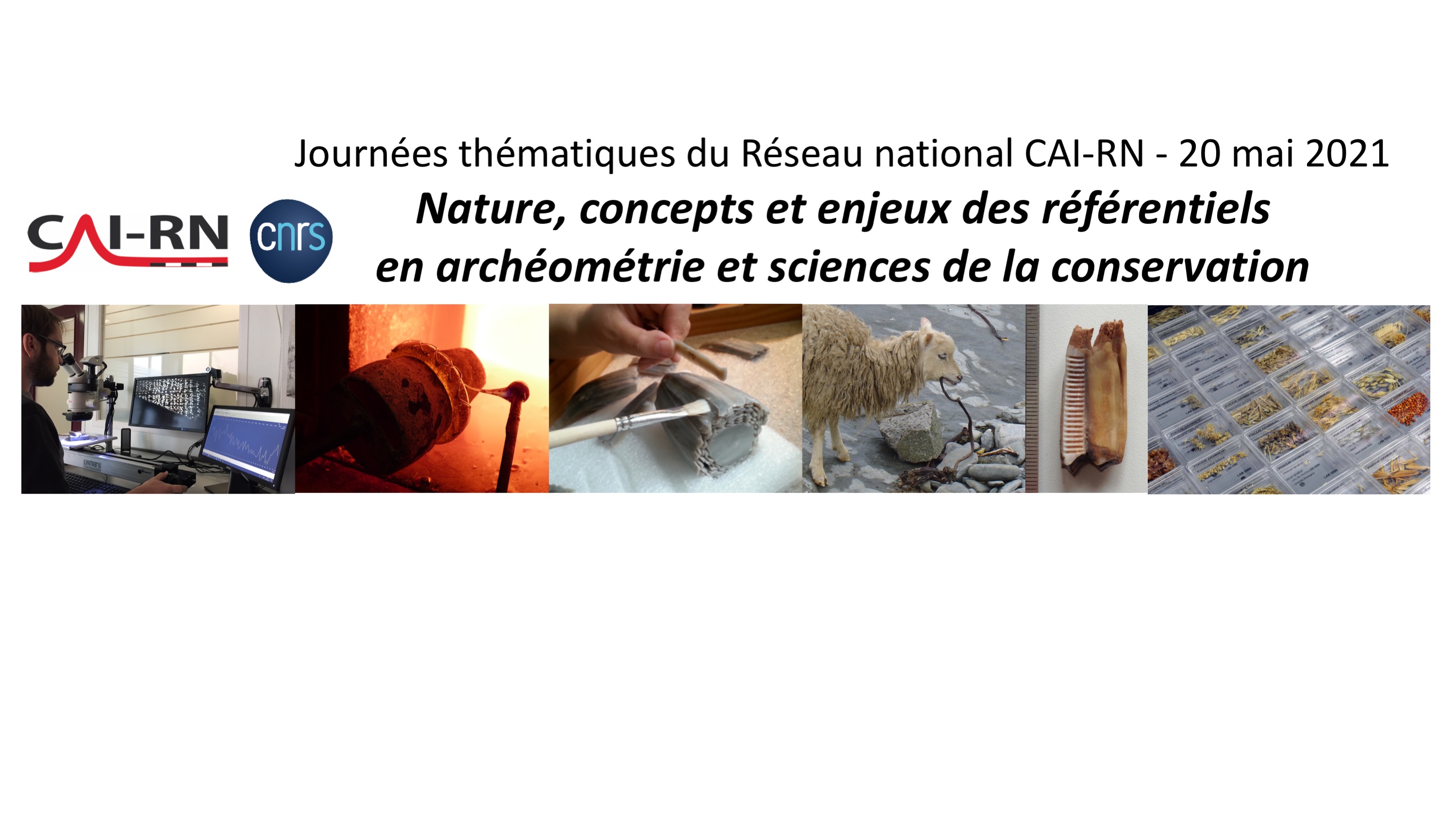Notice
Analysis of Artefact Form: the application of morphometric methods to archaeology / Renata Pedroso de Araujo
- document 1 document 2 document 3
- niveau 1 niveau 2 niveau 3
Descriptif
Analysis of Artefact Form: the application of morphometric methods to archaeology / Renata Pedroso de Araujo, in colloque "1st Virtual Conference for Women Archaeologists and Paleontologists. Nouveaux apports à l’étude des populations et environnements passés" organisé par le laboratoire Travaux et Recherches Archéologiques sur les Cultures, les Espaces et les Sociétés (TRACES) de l’Université Toulouse Jean Jaurès et le laboratoire Paléontologie Évolution Paléoécosystèmes (PALEVOPRIM) de l'Université de Poitiers, sous la responsabilité scientifique de Julie Bachellerie, Ana Belén Galán López (Traces), Émilie Berlioz et Margot Louail (Palevoprim). Université Toulouse Jean Jaurès, 8-9 mars 2021. [Conférence enregistrée à distance].
Session 3 : Exploitation of natural resources and raw materials, subsistence strategies.
This presentation will verse on the subject andmethods used in my doctoral research project. I am currently developingresearch in Brazilian archaeology, with a project aiming to contribute to theunderstanding of the occupation processes of southeastern Brazil byhunter-gatherer groups during the Holocene. More specifically, this researchfocusses on the State of São Paulo, concentrating on the study of two classesof formal lithic artefacts, namely bifacial projectile points and unifacial,plane-convex scrapers. The scope of the research is to characterize thediversity of the southeastern Brazilian lithic industries by means of amorphometric approach, in order to explore the differences or similarities inthe 2 characteristics of bifacial points and unifacial artefacts of São Pauloterritory in relation to these same artefact classes found in the south (UmbuTradition, with bifacial points) and in the midwest and part of the northeastof the country (Itaparica Tradition, with unifacial artefacts). These data willbe theoretically interpreted in light of the assumptions of CulturalTransmission Theory, aiming the proposal of hypotheses related to the scenariosof regional settlement, territory delineation and cultural contact, andrelating these scenarios to the population dynamics of these human groupsthroughout the Holocene. The endeavors for application of morphometric methodsto the morphological analysis of material culture is fairly new –a little morethan a decade– and it has been gaining more interest among archaeologists asan effective, quantitative and complementary approach to the more disseminatedtechnological analyses, mainly regarding lithic artefacts. This project has notyielded research results so far, so the idea for this occasion is to presentresults of recent morphometric works applied to lithic studies in Brazil and tointroduce the morphometric approach as a promising method of analysis inarchaeological studies.
Thème
Documentation
Références documentaires
ADAMS, D.C., ROHLF, F.J. & Slice, D.E. 2004. Geometric Morphometrics: Ten Years of Progress Following the ‘Revolution’. Italian Journal of Zoology 71, 5–16.
ADAMS, D.C., ROHLF, F.J. & Slice, D.E. 2013. A field comes of age: geometric morphometrics in the 21st century. Hystrix, 24(1), 7.
BENÍTEZ, H. A. & PÜSCHEL, T. A. 2014. Modelando la varianza de la forma: morfometría geométrica aplicaciones en biología evolutiva. Int. J. Morphol., 32(3), 998-1008.
BOOKSTEIN, F.L. 1991. Morphometric Tools for Landmark Data: Geometry and Biology. Cambridge University Press, Cambridge.
BUCHANAN, B. & COLLARD, M. 2010a. A geometric morphometrics-based assessment of blade shape differences among Paleoindian projectile point types from western North America. Journal of Archaeological Science, 37, 350-359.
CARDILLO, M. 2010. Some applications of geometric morphometrics to archaeology. In ELEWA, A.M.T. (Ed.) Morphometrics to Nonmorphometricians. Springer, 325-341.
CHARLIN, J., CARDILLO, M. & BORRAZZO, K. 2014. Spatial Patterns in Late Holocene Lithic Projectile Point Technology of Tierra del Fuego (Southern South America): Assessing Size and Shape Changes. World Archaeology 46 (1), 78-100.
EERKENS, J.W. & LIPO, C.P. 2007. Cultural transmission theory and the archaeological record: providing context to understanding variation and temporal changes in material culture. Journal of Archaeological Research, 15(3), 239-274.
OKUMURA, M. & ARAUJO, A.G.M. 2014. A Long-term cultural stability in hunter-gatherers: a case study using traditional and geometric morphometrics of lithic stemmed bifacial points from Southern Brazil. Journal of Archaeological Science, 45, 59-71.
OKUMURA, M. & ARAUJO, A.G.M. 2016. The Southern Divide: Testing morphological differences among bifacial points from Southern and South-eastern Brazil using geometric morphometrics. Journal of Lithic Studies, vol. 3, nr. 1, 107-131.
PEDROSO DE ARAUJO, R. 2018. Por uma abordagem geoarqueológica: a interface entre a Arqueologia e as Ciências da Terra e a ênfase no contexto espacial, Cadernos do LEPAARQ (UFPEL), 29, vol. 15, 20-39. [En ligne : https://pdfs.semanticscholar.org/75ec/87614eea186d9b304cb1e56683e337ef1f78.pdf].
SMITH, H.L., KUZMINSKY, S.C. & LINDERHOLM, A. 2020. Discerning Dispersals along the Pacific and Interior Corridors: Contributions of Geometric Morphometrics to the Peopling of the Americas. PaleoAmerica, 6(1), 109-130.
VILLALOBOS-LEIVA, A. & BENÍTEZ, H. A. 2020. Morfometría geométrica y sus nuevas aplicaciones en ecología y biología evolutiva. Parte 2. International Journal of Morphology, 38(6), 1818-1836.
VISCOSI, V. & CARDINI, A. 2011. Leaf morphology, taxonomy and geometric morphometrics: a simplified protocol for beginners. PLoS One 6, 25630.
ZELDITCH, M.L., SWIDERSKI, D.L., SHEETS, D.H. & FINK, W.L. 2012. Geometric Morphometrics for Biologists: a Primer. Elsevier, Academic Press, New York.
Liens
Programme du colloque "1st Virtual Conference for Women Archaeologists and Paleontologists" (8-9 mars 2021)
Website du Laboratoire Paléontologie Évolution Paléoécosystèmes Paléoprimatologie (PALEVOPRIM)
Livret des résumés des communications du colloque "1st Virtual Conference for Women Archaeologists and Paleontologists. Nouveaux apports à l’étude des populations et environnements passés" (8-9 mars 2021)
Site internet dédié au colloque "1st Virtual Conference for Women Archaeologists and Paleontologists" (8-9 mars 2021)
Dans la même collection
-
Sensivity analysis to morphological changes of the shoulder joint: application to percussio…
BLASI-TOCCACCELI Alicia
Sensivity analysis to morphological changes of the shoulder joint: application to percussion gestures during Oldowan debitage / Alicia Blasi-Toccacceli, in colloque "1st Virtual Conference for
-
"Ouranopithecus macedoniensis" (late Miocene, Greece): analysis of mandibular fragments using …
IOANNIDOU Melania
Ouranopithecus macedoniensis (late Miocene, Greece): analysis of mandibular fragments using 3D geometric morphometrics / Melania Ioannidou, in colloque "1st Virtual Conference for Women
-
Comminution capabilities of extant and fossil anthropoids during molar intercuspation: a preliminar…
WALKER Axelle E. C.
Comminution capabilities of extant and fossil anthropoids during molar intercuspation: a preliminary experiment using a chewing simulator / Axelle E. C. Walker, in colloque "1st Virtual Conference for
-
New sperm whale cranium from the late Miocene and a revised family attribution for the small crown …
ALFSEN Apolline
New sperm whale cranium from the late Miocene and a revised family attribution for the small crown physeteroid Thalassocetus / Apolline Alfsen, in colloque "1st Virtual Conference for Women
-
What is shaping the brain? A perspective on brain size evolution in carnivorans / Margot…
MICHAUD Margot
What is shaping the brain? A perspective on brain size evolution in carnivorans / Margot Michaud, in colloque "1st Virtual Conference for Women Archaeologists and Paleontologists. Nouveaux
-
Postnatal shape changes in the rodent mandible at a macroevolutionary scale / Morgane Dubied
DUBIED Morgane
Postnatal shape changes in the rodent mandible at a macroevolutionary scale / Morgane Dubied, in colloque "1st Virtual Conference for Women Archaeologists and Paleontologists. Nouveaux apports à l
-
Cranial vault healing in modern humans: input of archaeological and clinical data / Aliéno…
LEPETIT Aliénor
Cranial vault healing in modern humans: input of archaeological and clinical data / Aliénor Lepetit, in colloque "1st Virtual Conference for Women Archaeologists and Paleontologists. Nouveaux
-
A transdisciplinary approach to reconstruct the Nilotic socio-ecosystem in Luxor west bank during t…
NICATORE Giulia
A transdisciplinary approach to reconstruct the Nilotic socio-ecosystem in Luxor west bank during the Ptolemaic period (3rd-1st centuries BC.) / Giulia Nicatore, in colloque "1st Virtual Conference
-
From monoliths to megaliths: a new approach on the megalithic burials of southwestern France / Bosc…
BOSCUS Sarah
From monoliths to megaliths: a new approach on the megalithic burials of southwestern France / Boscus Sarah, in colloque "1st Virtual Conference for Women Archaeologists and Paleontologists. Nouveaux
-
Tracing Human Ancestral Migration from its Symbiotic Bacteria / Alexia Nguyen Trung
NGUYEN TRUNG Alexia
Tracing Human Ancestral Migration from its Symbiotic Bacteria / Alexia Nguyen Trung, in colloque "1st Virtual Conference for Women Archaeologists and Paleontologists. Nouveaux apports à l’étude des
-
Foragers and their symbolic landscape. Understanding the role of rock art in the territoriality of …
JOBARD Léa
Foragers and their symbolic landscape. Understanding the role of rock art in the territoriality of Later Stone Age Matobo populations / Léa Jobard, in colloque "1st Virtual Conference for Women
-
Towards a tracking of past bird seasonal migrations through geological times: what could isotopes t…
DUHAMEL Anaïs
Towards a tracking of past bird seasonal migrations through geological times: what could isotopes tell us? / Anaïs Duhamel, in colloque "1st Virtual Conference for Women Archaeologists and
Sur le même thème
-
Événements naturels extrêmes : quels impacts sur l’environnement, les paysages et les populations ?…
VERNET Gérard
Gérard Vernet (Inrap/ Laboratoire Magmas et Volcans) présente « Événements naturels extrêmes : quels impacts sur l’environnement, les paysages et les populations ? L’exemple de la Limagne d’Auvergne
-
Trajectoires évolutives récentes des arbres
KREMER Antoine
Antoine Kremer, directeur de recherche émérite à l’INRAE, discute dans cette vidéo (8’34) des dynamiques évolutives des arbres.
-
Les vignes romaines : approches morphométrique et archéogénomique
BOUBY Laurent
Les vignes romaines : approches morphométrique et archéogénomique
-
C. BRASSARD et al., Explorer l’évolution fonctionnelle de la mâchoire des chiens en s’appuyant sur …
Explorer l’évolution fonctionnelle de la mâchoire des chiens en s’appuyant sur des modèles établis à partir de spécimens actuels : exemple d’application à des chiens européens du pré-Age du Bronze
-
Sensivity analysis to morphological changes of the shoulder joint: application to percussio…
BLASI-TOCCACCELI Alicia
Sensivity analysis to morphological changes of the shoulder joint: application to percussion gestures during Oldowan debitage / Alicia Blasi-Toccacceli, in colloque "1st Virtual Conference for
-
"Ouranopithecus macedoniensis" (late Miocene, Greece): analysis of mandibular fragments using …
IOANNIDOU Melania
Ouranopithecus macedoniensis (late Miocene, Greece): analysis of mandibular fragments using 3D geometric morphometrics / Melania Ioannidou, in colloque "1st Virtual Conference for Women
-
Cranial vault healing in modern humans: input of archaeological and clinical data / Aliéno…
LEPETIT Aliénor
Cranial vault healing in modern humans: input of archaeological and clinical data / Aliénor Lepetit, in colloque "1st Virtual Conference for Women Archaeologists and Paleontologists. Nouveaux
-
From monoliths to megaliths: a new approach on the megalithic burials of southwestern France / Bosc…
BOSCUS Sarah
From monoliths to megaliths: a new approach on the megalithic burials of southwestern France / Boscus Sarah, in colloque "1st Virtual Conference for Women Archaeologists and Paleontologists. Nouveaux
-
Study of human group behaviors during the Last Glacial Maximum in the east Carpathian area from zoo…
DEMAY Laëtitia
Study of human group behaviors during the Last Glacial Maximum in the east Carpathian area from zooarchaeological remains / Laëticia Demay, in colloque "1st Virtual Conference for Women Archaeologists
-
From sooty speleothems analysis to the study of occupation dynamics of caves by prehistoric societi…
VANDEVELDE Ségolène
From sooty speleothems analysis to the study of occupation dynamics of caves by prehistoric societies / Ségolène Vandevelde, in colloque "1st Virtual Conference for Women Archaeologists and
-
An analysis of Iron Age Scottish wetland deposition practices /Tiffany Treadway
TREADWAY Tiffany
An analysis of Iron Age Scottish wetland deposition practices / Tiffany Treadway, in colloque "1st Virtual Conference for Women Archaeologists and Paleontologists. Nouveaux apports à l’étude des
-
Gender Trouble: towards a deconstruction of binarity in archaeology / Laura Mary
MARY Laura
Gender Trouble: towards a deconstruction of binarity in archaeology / Laura Mary, in colloque "1st Virtual Conference for Women Archaeologists and Paleontologists. Nouveaux apports à l’étude des

